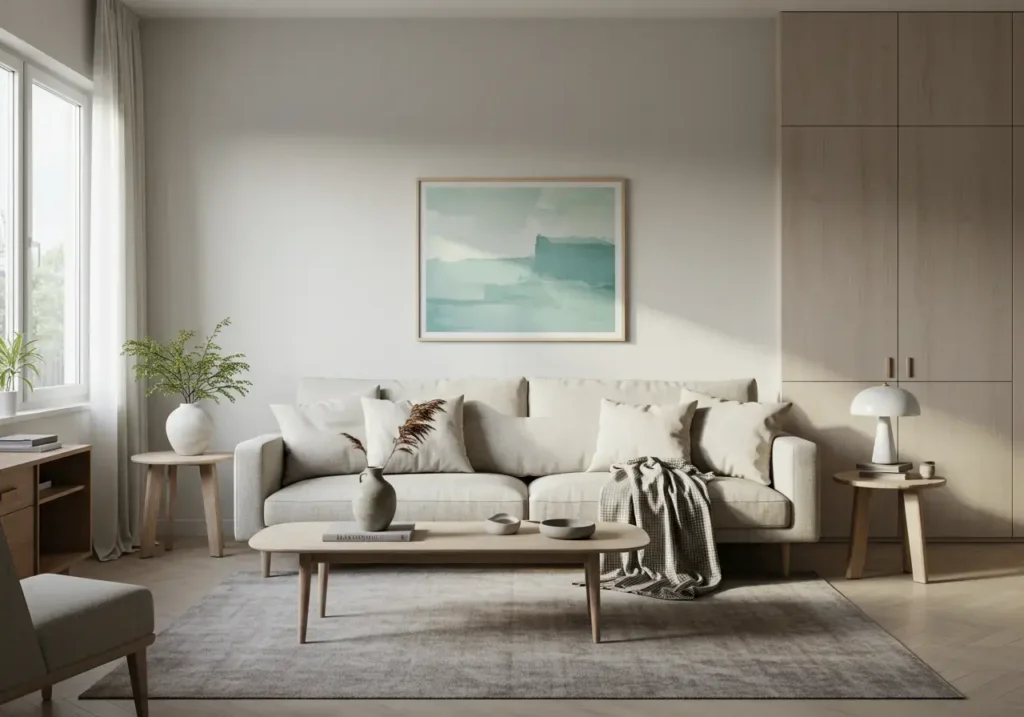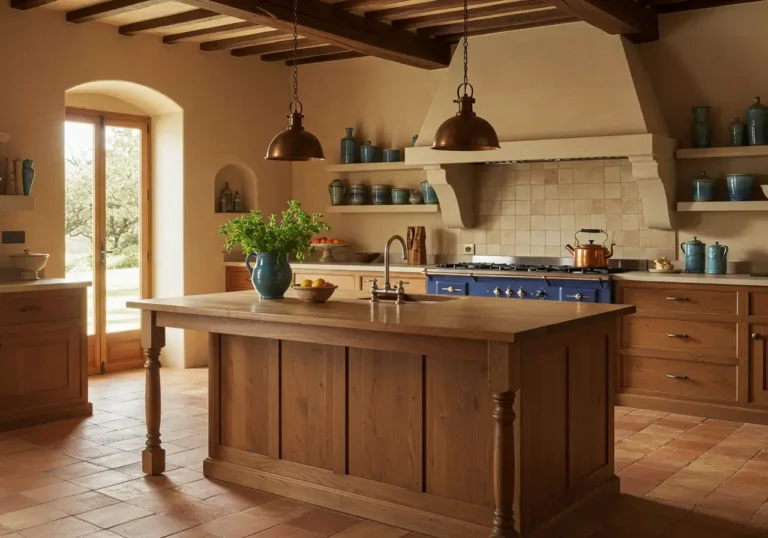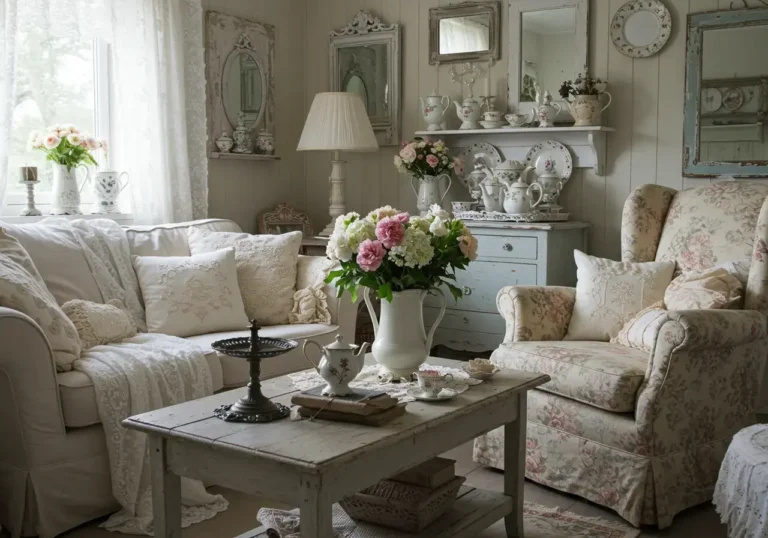Hey there! As someone who’s juggled busy days and the constant battle against clutter, I totally get the appeal of a calm, uncluttered space. There’s just something about walking into a living room that feels light, open, and completely relaxing, isn’t there? It’s not about having *nothing*, but about having *just the right things* in the *right places*. That’s the magic of a minimalist living room. If you’ve been dreaming of a space where you can truly unwind and declutter your life, you’re in the right place. I’m so excited to share some of my favorite tips and personal insights on how to create that peaceful, minimalist haven.
Streamline Your Minimalist Living Room Furniture Layout
Okay, let’s start with the big stuff: your furniture. When I first started my journey towards a more minimalist home, I realized I had furniture just because I had space. But for a minimalist living room, every piece needs to serve a purpose and contribute to the feeling of calm. Think quality over quantity here. I remember getting rid of an extra armchair that just collected laundry; instantly, the room felt lighter!
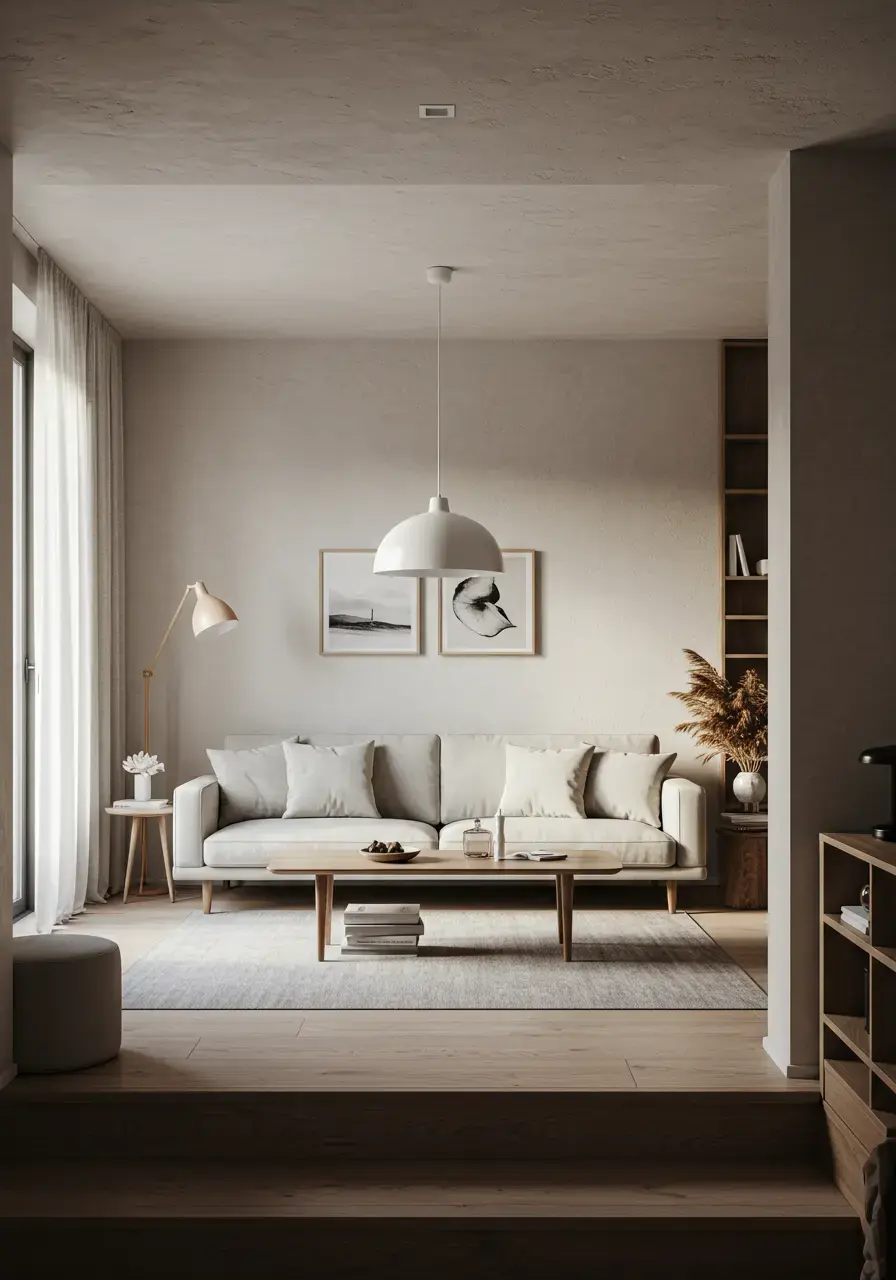
Why This Works:
A streamlined layout removes visual noise and makes your living area feel much more spacious and organized. It allows for easier movement and creates a sense of calm.
How You Can Recreate It:
- Identify the absolute essentials: a comfortable sofa, perhaps a coffee table, and necessary seating.
- Arrange furniture to create clear pathways and avoid blocking natural light sources.
- Consider multi-functional pieces, like an ottoman with storage, to reduce the need for extra items.
Embrace Open Space in Your Minimalist Living Room Design
This is key to the whole minimalist vibe. It’s about letting your room breathe. Instead of filling every corner, intentionally leave some areas open. This is something I learned the hard way; I used to feel like empty spots meant my decorating wasn’t ‘finished.’ Now, I see them as part of the design, allowing the eye to rest.
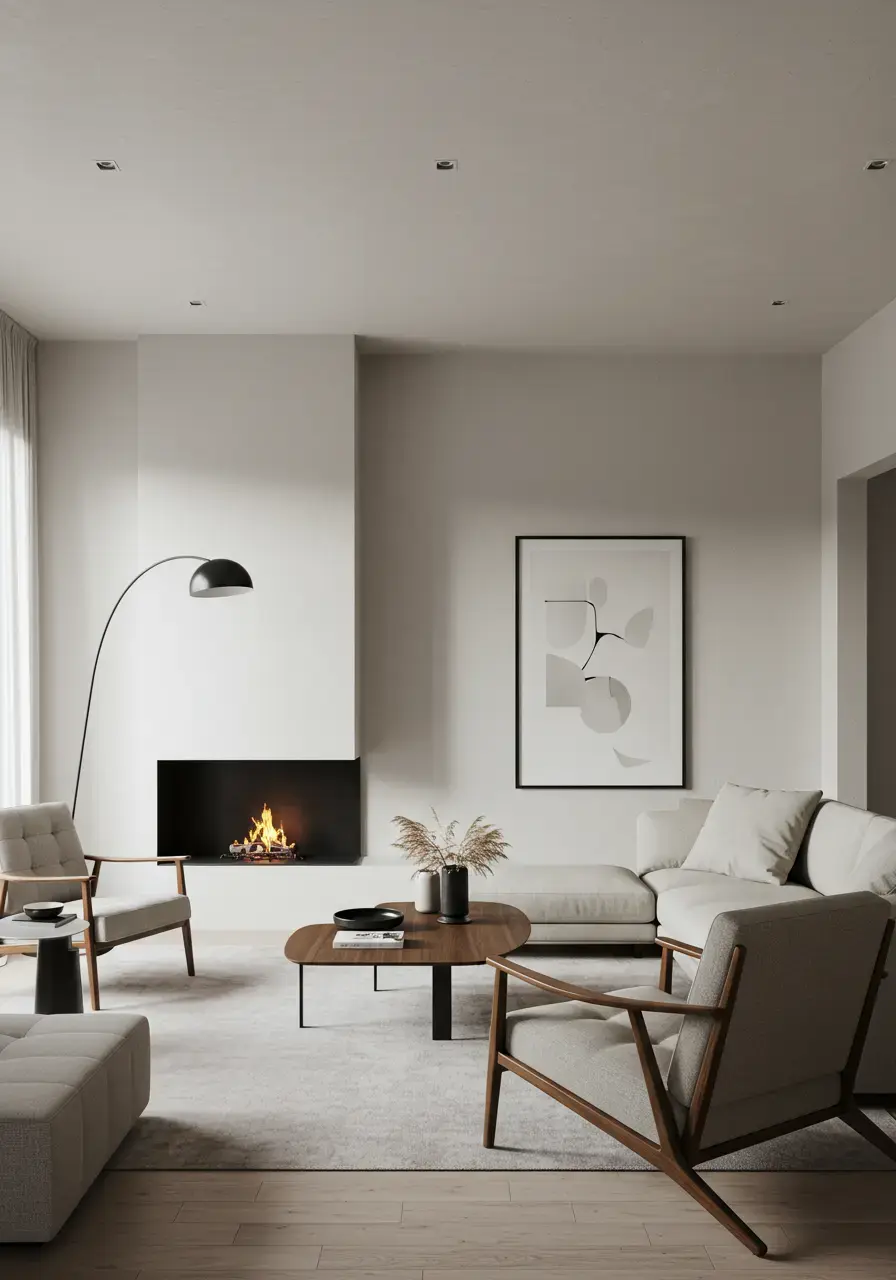
Why This Works:
Open space is fundamental to minimalism. It creates a sense of tranquility, makes the room feel larger, and highlights the pieces you *do* have.
How You Can Recreate It:
- Pull furniture away from walls slightly rather than pushing everything flush.
- Avoid crowding furniture together; give each piece room to stand out.
- Resist the urge to fill empty corners with decorative items.
Curate a Calm Color Palette for a Minimalist Living Room Vibe
Color plays such a huge role in how a room *feels*. For a minimalist living room, you want colors that soothe, not stimulate. Think soft neutrals, like whites, creams, beiges, and gentle grays. My living room is primarily soft white with touches of warm wood, and honestly, it instantly lowers my stress levels when I walk in after a long day.

Why This Works:
A calm color palette contributes significantly to a serene and uncluttered aesthetic. Neutral tones are timeless and create a harmonious backdrop.
How You Can Recreate It:
- Choose a base color (like white or a soft beige) for walls.
- Select furniture and textiles in shades of your base color or complementary neutrals.
- Use subtle variations of your chosen colors rather than introducing too many different hues.
Select Smart Storage Solutions for a Minimalist Living Room
Living in a minimalist way doesn’t mean you can’t have ‘stuff.’ It just means your stuff needs a home! Clutter is less likely to accumulate if everything has a designated spot *out of sight*. I rely on a few key pieces with hidden storage, and it’s a game-changer for keeping surfaces clear.
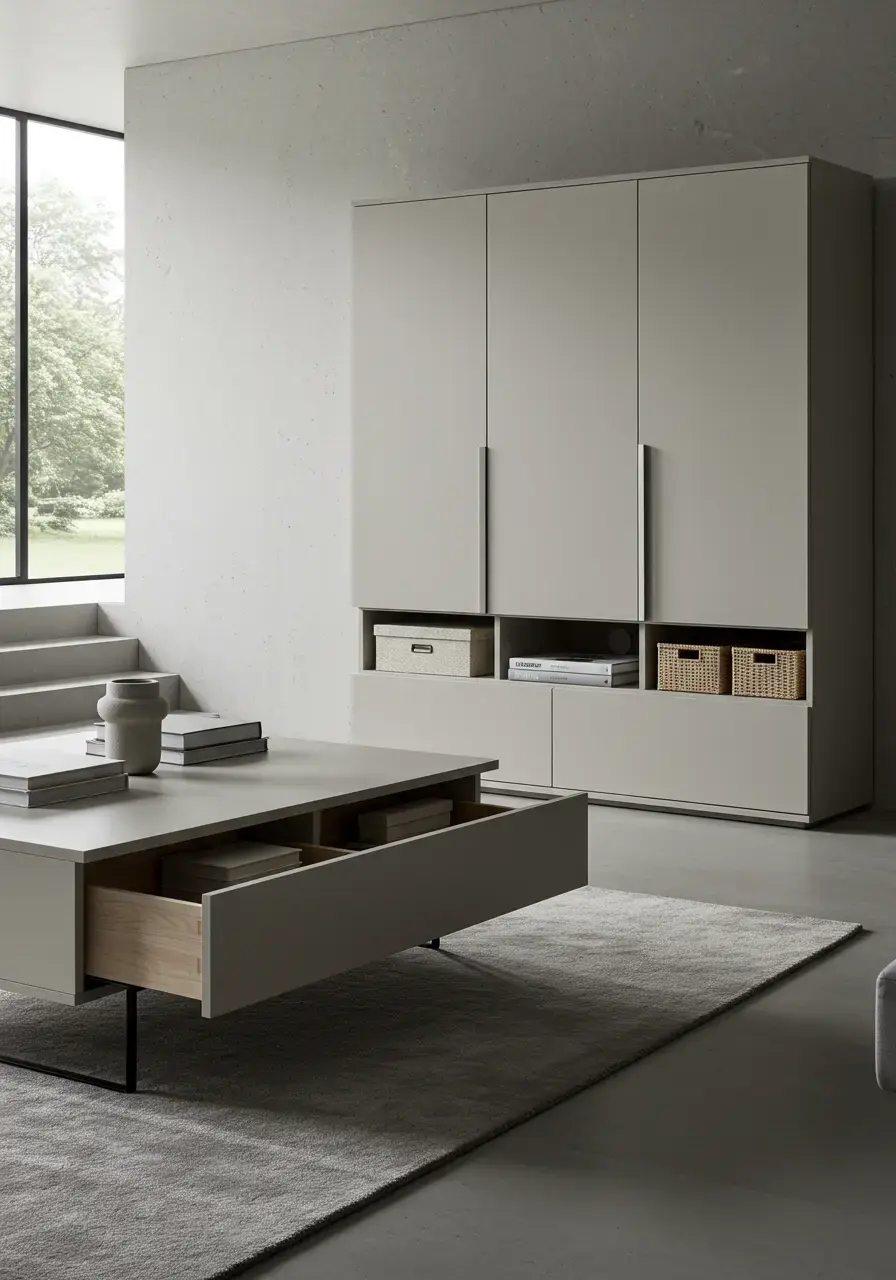
Why This Works:
Effective storage keeps clutter hidden, maintaining the clean lines and uncluttered appearance essential to a minimalist living room.
How You Can Recreate It:
- Choose furniture with built-in storage, like coffee tables with drawers or ottomans with lift-off tops.
- Utilize closed cabinets or media consoles to hide electronics, books, and other items.
- Use decorative boxes or baskets *within* cabinets or on shelves to organize smaller items.
Declutter Surfaces to Enhance Your Minimalist Living Room Appeal
This is probably the *most* impactful thing you can do to create a minimalist feel. Clear surfaces just look and feel so much cleaner and more peaceful. Think back to my laundry-collecting armchair; surfaces are similar! Before guests come over, I always do a ‘surface sweep’ in my minimalist living room, and it takes minutes but makes a huge difference.
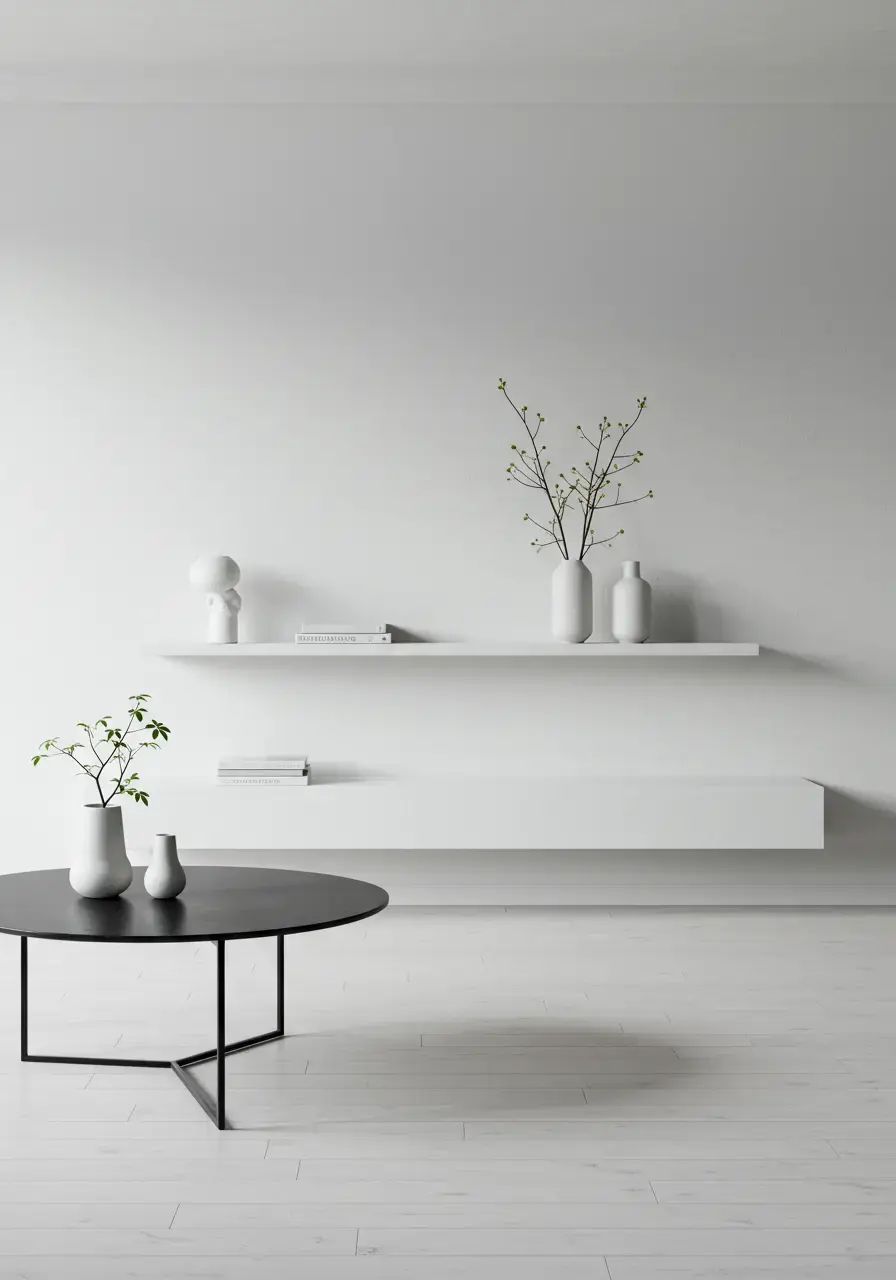
Why This Works:
Cluttered surfaces create visual chaos and make a room feel smaller and more stressful. Clear surfaces promote a sense of order and spaciousness.
How You Can Recreate It:
- Remove anything that doesn’t belong or isn’t essential from tables, shelves, and other surfaces.
- Designate specific homes for items that tend to accumulate (like mail, keys, remotes).
- Limit decorative items on surfaces to just a few curated pieces.
Choose Essential Decor Pieces for a Minimalist Living Room
Minimalism isn’t about being boring! You can still have personality; you just choose your decor very deliberately. Each piece should feel meaningful or bring you joy. Instead of lots of small trinkets, opt for one or two larger, impactful pieces. I have one beautiful ceramic vase on my coffee table, and it draws your eye without making the space feel busy.

Why This Works:
Carefully chosen decor adds personality and warmth without introducing visual clutter. It allows each piece to be appreciated.
How You Can Recreate It:
- Select a few high-quality, meaningful decorative items rather than many small ones.
- Consider the shape, form, and texture of each piece.
- Ensure decorative items complement your chosen color palette and overall style.
Utilize Natural Light in Your Minimalist Living Room
Natural light is a minimalist’s best friend! It makes any space feel brighter, airier, and more open. Heavy curtains can make a room feel smaller and darker, which is the opposite of what we want in a minimalist living room. I swapped my heavy drapes for sheer blinds, and the difference was amazing.

Why This Works:
Maximizing natural light enhances the sense of spaciousness and brightness crucial to minimalist design. It creates a positive and uplifting atmosphere.
How You Can Recreate It:
- Use sheer or light-colored window treatments that allow light to filter through.
- Keep windows clean to maximize the light entering the room.
- Arrange furniture to avoid blocking windows.
Layer Textures for Added Depth and Style
A common misconception about minimalism is that it has to be stark or cold. Absolutely not! You can bring warmth and interest through texture. Think cozy throws, soft rugs, textured pillows. I love how layering different textures, even in a neutral palette, makes my minimalist living room feel so inviting and comfortable.
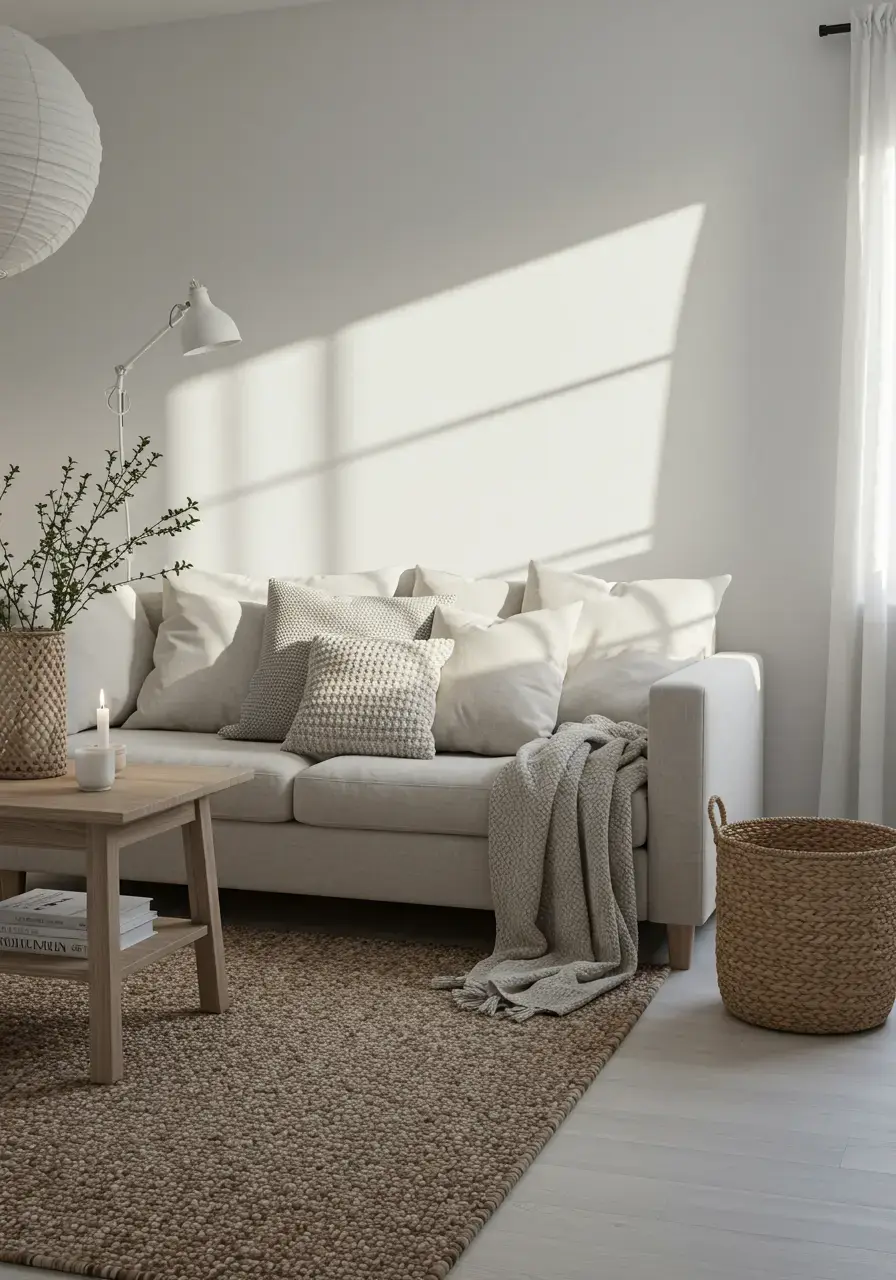
Why This Works:
Layering textures in a minimalist space adds visual interest and warmth without relying on color or excessive objects. It prevents the room from feeling sterile.
How You Can Recreate It:
- Introduce a soft rug, like a wool or natural fiber one, to anchor the seating area.
- Add throw pillows and blankets in varying textures (linen, knit, faux fur).
- Consider furniture pieces with interesting textures, like a wooden coffee table or a woven basket.
Incorporate Greenery for a Fresh Feel
Plants are fantastic for bringing life and a touch of nature into any room, and they fit perfectly into a minimalist aesthetic. They add a pop of color and texture without being visually cluttered. Plus, they’re just lovely to look at! I have a few simple houseplants in my minimalist living room, and they instantly brighten the space.

Why This Works:
Plants add natural beauty, a touch of color, and a sense of aliveness. They contribute to a calming atmosphere and can even improve air quality.
How You Can Recreate It:
- Choose a few low-maintenance plants that suit your space and light conditions.
- Select simple, understated planters that complement your minimalist design.
- Place plants strategically to add a focal point or fill a corner without overwhelming the space.
Define Zones Within Your Space Simply
If your living room is part of a larger open plan, defining different areas can help the space feel more organized and functional, even within a minimalist style. You don’t need walls! Just subtle visual cues. I use a rug to mark the seating area, which keeps that part of my minimalist living room feeling cozy and separate from the dining area.
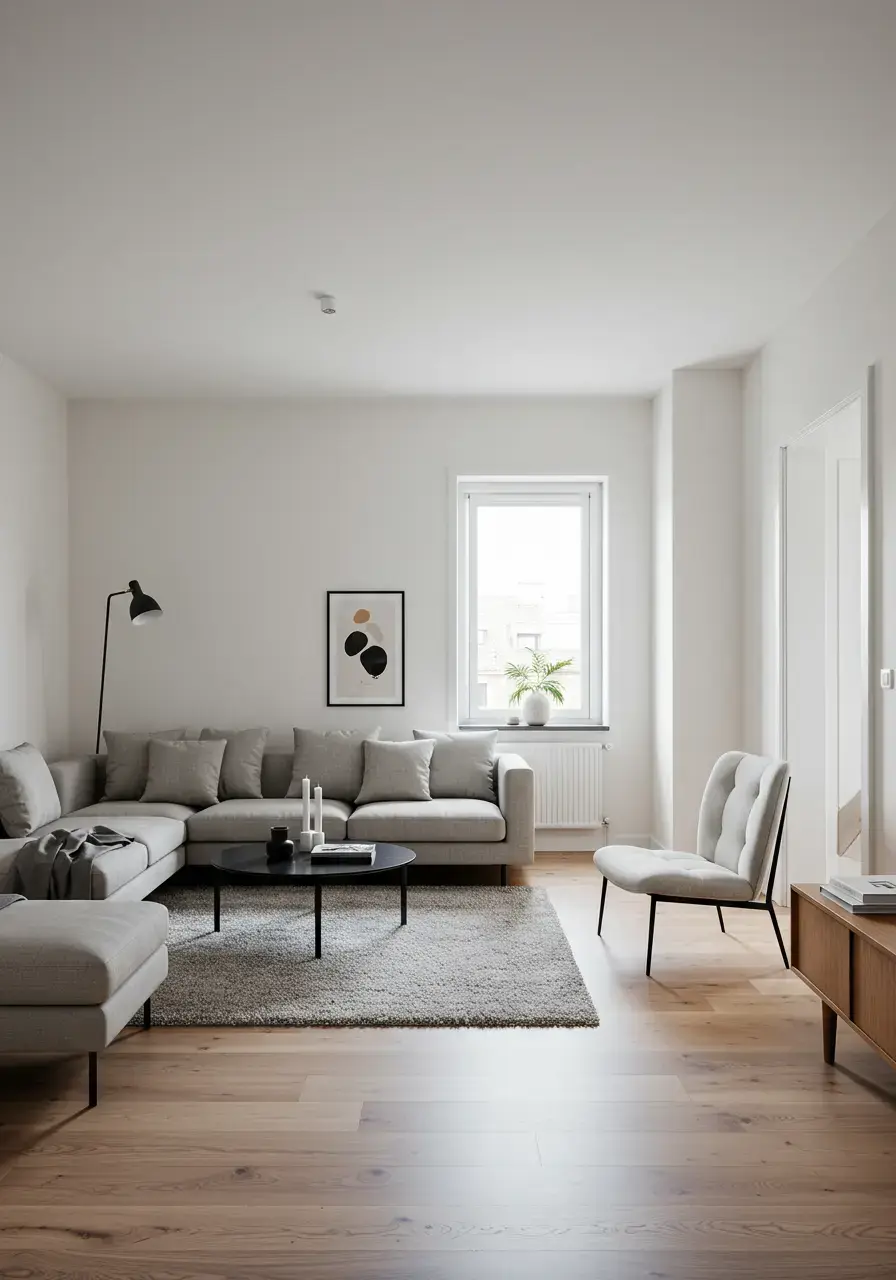
Why This Works:
Defining zones creates a sense of structure and purpose for different areas within the living room, improving flow and functionality.
How You Can Recreate It:
- Use rugs to visually delineate seating areas or walkways.
- Arrange furniture to create distinct groupings.
- Use lighting to highlight specific zones, like a reading corner.
Select Art That Reflects Serenity
Art is personal, but for a minimalist space, I like pieces that evoke a sense of calm or quiet. Large, abstract pieces in muted colors, tranquil landscapes, or simple line drawings work beautifully. One large piece over the sofa is often more impactful than a busy gallery wall in a minimalist living room.
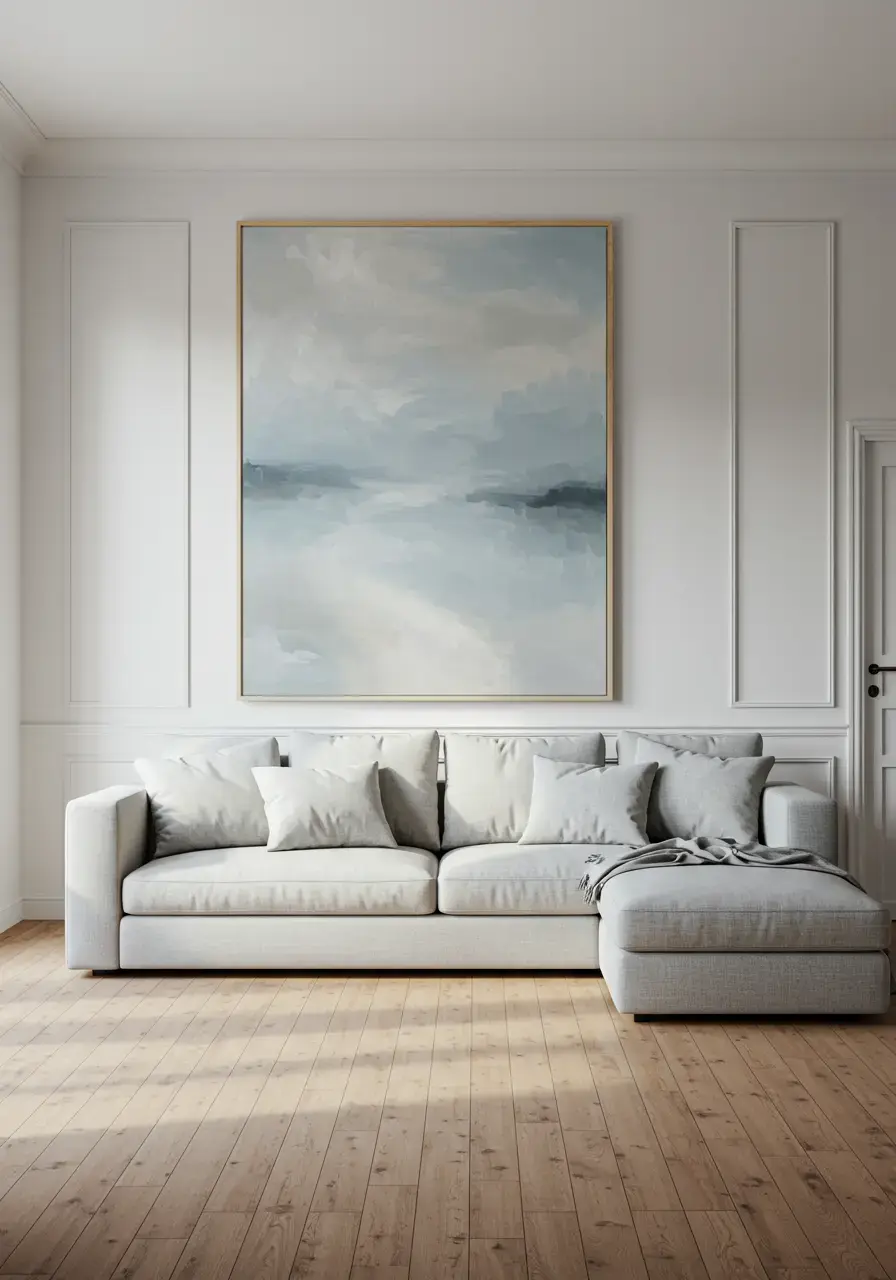
Why This Works:
Thoughtfully chosen art adds personality and a focal point without creating visual clutter. Art that reflects serenity enhances the overall peaceful atmosphere.
How You Can Recreate It:
- Choose art with a calm color palette or simple composition.
- Consider a single large piece of art or a small grouping of complementary pieces.
- Select frames that are simple and modern or go frameless for a super clean look.
Keep Floors Clear and Uncluttered
This might seem obvious, but it makes such a huge difference to the feeling of spaciousness and calm in a minimalist living room. Clear floors just feel so light and easy. Tripping hazards aside, they allow your eye to move smoothly across the room, making it feel bigger.
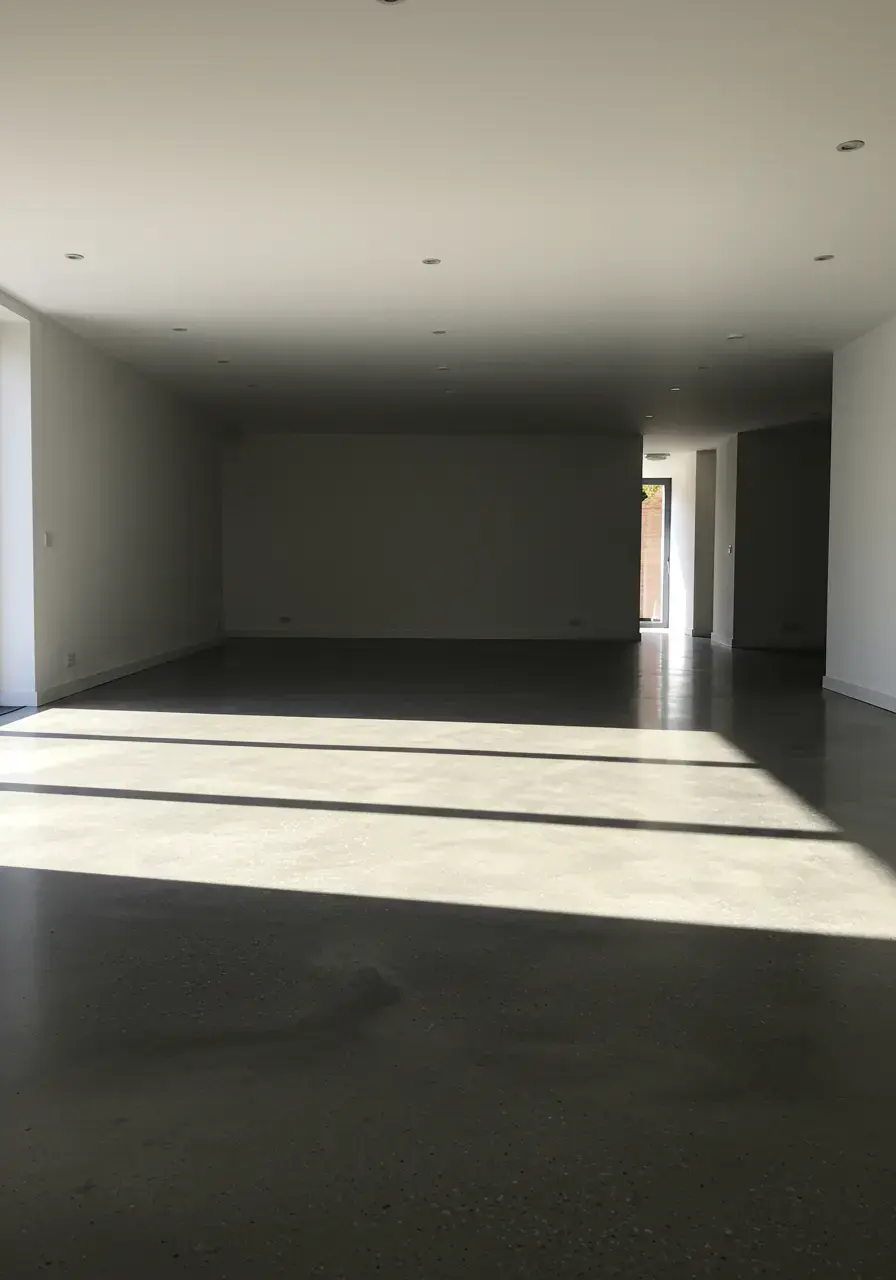
Why This Works:
Uncluttered floors are essential for creating a spacious and tidy look. They improve flow and prevent the room from feeling cramped.
How You Can Recreate It:
- Ensure toys, shoes, and other items have dedicated storage elsewhere.
- Avoid using the floor as temporary storage for bags or belongings.
- Sweep or vacuum regularly to maintain a clean and clear floor surface.
Conclusion
Creating a minimalist living room is truly about curating your space to support a more peaceful and intentional life. It’s not about deprivation, but about surrounding yourself with only what you need and love, giving those things room to shine. As I’ve embraced these 12 minimalist living room ideas, I’ve found my home feels more like a sanctuary, a place where I can truly relax and recharge. Start small, be patient with yourself, and enjoy the process of creating a space that feels perfectly you and perfectly peaceful.

